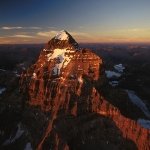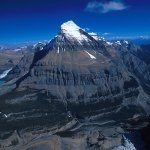Elk Lakes Provincial Park is a sub-alpine wilderness nestled above the tree line in the Front Ranges of the Rocky Mountains on the British Columbia-Alberta border. The scenery is breathtaking – there’s just something about lakes set against massive cliff faces, headwalls, waterfalls, craggy summits, and hanging icefalls that makes you stop in your tracks and utter a profound ‘wow.’
The mountains and glaciers in the northern part of the park immortalize French leaders of the First World War: Mount Pétain, Pétain Glacier, Mount Nivelle, Mount Joffre, Mount Foch and Mount Castelneaus. The bent limestone layers of Mount Aosta and Mount Fox are particularly interesting features of the park. These layers, which are angled at nearly 90º, have water spouting out from their vertices. These natural faucets, combined with the glacial meltwaters from the French Military Group’s glaciers form Upper Elk Lake. As a result, Upper Elk Lake tends to be laden with glacial rock flour and is very cold.
Most of the 17,245-hectare Elk Lakes Provincial Park is above the treeline and void of dense vegetation. However at lower elevations, forests of Englemann spruce and lodgepole pine blanket the bases of the park’s majestic peaks. Growing amongst the spruce and pine are juniper, twinberry, false azalea, white rhododendron and buffalo berry. Alpine meadows come alive after the spring thaw with colours of fireweed, Indian paintbrush, blue violet, elephant’s head and giant ragwort.
Temperatures in the summer sometimes reach 25ºC, but the average temperature is closer to 15ºC. Any daytime heat dissipates quickly at night, and temperatures often drop below freezing. The park is usually free of snow at lower elevations by mid-June, although trails will remain wet and muddy until the first part of July. The lakes are ice-free by mid-June and remain so until late in November.
Most of the hikes in Elk Lake justify the adjectives ‘strenuous,’ demanding,’ and ‘very demanding.’ The one exception is the walk from the parking lot to Lower Elk Lake. Muscle-taxing hiking trails lead from the park entrance to Elk Pass, along the shoreline to Upper Elk Lake, and to Pétain Creek Falls, and mountain climbing is also quite challenging here. Horseback riders will enjoy this park – the Cadorna Creek Watershed area has well established and durable trails. For the more adventurous, there is ample opportunity for mountain climbing on the many rock faces and craggy outcroppings throughout the park. For those interested in fishing, the park’s waters contain Dolly Varden, Rocky Mountain whitefish and cutthroat trout. Winter recreation is somewhat curtailed here, due to the park’s remote location and unfavourable weather conditions.
Camping is permitted in the parking lot and on the grassy area adjacent to the park entrance – no facilities are provided; at Lower Elk Lake – pit toilets, firepits, food caches, tent pads provided; Pétain Creek approximately 1km past the south end of Upper Elk Lake on a gravel terrace – tent pads, pit toilets, food caches and group fire rings provided; at Pétain Glacier mountaineering bivouac site located above Pétain Falls – no facilities provided; and in the Cadorna Creek Watershed.
The backcountry campground at Abruzzi Lake offers a pit toilet, metal fire ring and two tent pads. Please use existing rock rings and impacted campsites throughout the Cadorna Watershed. Where there are no existing campsites, please practice minimum impact camping. The Alpine Club of Canada operates a small lodge at the trailhead and the entrance of the park.
Elk Lakes Provincial Park is located about 65 miles (104 km) north of Sparwood. From Sparwood, travel north on Highway 43 for 22 miles (35 km) to Elkford. From Elkford, travel the gravel road on the west side of the river for 29 miles (47 km), at which point the road crosses the Elk River and joins the Kananaskis Power Line Road. From there it is 3.6 miles (5.8 km) to the Cadorna Creek trailhead and an additional 10 miles (16.1 km) to the Elk Lakes trailhead.
Nearby Regions & Towns
Park Notices



